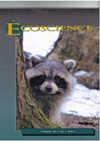Weak Evidence of Spatial Segregation between the Vulnerable Southern Water Vole (Arvicola sapidus) and the Two Main Invasive Mammals of European Freshwater Ecosystems
IF 1.3
4区 环境科学与生态学
Q3 ECOLOGY
引用次数: 0
Abstract
ABSTRACT Niche differentiation by spatial segregation facilitates the coexistence of species sharing ecological preferences, which can buffer the impact of biological invasions on native species. The introduction of two semi-aquatic rodents, the coypu Myocastor coypus and the muskrat Ondatra zibethicus, to most freshwater ecosystems across Western Europe, has been pinpointed as a cause for the decline of the southern water vole (SWV) Arvicola sapidus. We investigated the co-occurrence of these three species in a river catchment of northwest France and whether spatial habitat segregation took place at two spatial scales, using hierarchical modelling accounting for imperfect detection. At a large spatial scale (river catchment), the occupancy rate of the SWV was 0.52 ± 0.06, i.e. noticeably smaller compared to coypu (0.58) and muskrat (0.80). We found no evidence of a negative effect of the presence of the two invasive rodents on SWV occurrence. At a smaller spatial scale (SWV home range), we found weak evidence of spatial segregation in habitat use with a negative, although not significant, effect of muskrat. Overall, our results suggest that riparian habitats in the study area allow the southern water vole to coexist with two larger invasive rodents, provided that hygrophytic vegetation is preserved alongside rivers. RÉSUMÉ La différenciation des niches par ségrégation spatiale est un processus qui facilite la coexistence d'espèces partageant les mêmes préférences écologiques. Ce processus peut atténuer l'impact des invasions biologiques sur les espèces natives. L'introduction de deux rongeurs semi-aquatiques, le ragondin (Myocastor coypus) et le rat musqué (Ondatra zibethicus), dans la plupart des écosystèmes d'eau douce d'Europe occidentale, a été identifiée comme une cause du déclin du campagnol aquatique (Arvicola sapidus). A l'aide de modèles hiérarchiques tenant compte de la détection imparfaite des espèces, nous avons étudié à deux échelles spatiales différentes la co-occurrence de ces trois espèces dans un bassin hydrographique du nord-ouest de la France. Nous avons cherché à déterminer s'il existait un phénomène de ségrégation spatiale entre les 3 espèces. À large échelle (bassin versant), le taux d'occupation du campagnol aquatique est de 0,52 ± 0,06, c'est-à-dire sensiblement plus faible que celui du ragondin (0,58) et du rat musqué (0,80). Nous n'avons trouvé aucune preuve d'un effet négatif de la présence de ces deux rongeurs envahissants sur l'occurrence du campagnol aquatique. À plus petite échelle (territoire du campagnol aquatique), nous avons trouvé une faible preuve de ségrégation spatiale dans l'utilisation de l'habitat avec un effet négatif, bien que non significatif, de la présence du rat musqué. Dans l'ensemble, nos résultats suggèrent que les ripisylves de la zone d'étude permettent au campagnol aquatique de co-exister avec deux rongeurs envahissants de taille supérieure, à condition que la végétation hygrophile soit préservée le long des rivières.脆弱的南方水豚(Arvicola sapidus)与欧洲淡水生态系统中两种主要入侵哺乳动物之间空间分离的微弱证据
空间隔离的生态位差异促进了具有共同生态偏好的物种共存,这可以缓冲生物入侵对本地物种的影响。将两种半水生啮齿动物,Coypu myocastor Coypus和Muskrat ondatra zibethicus引入西欧最淡水的生态系统,被认为是南部水禽(SWV)Arvicola sapidus衰落的原因。我们研究了这三个物种在法国西北部河流集水区的共存情况,以及空间栖息地隔离在两个空间尺度上的位置,使用分层建模计数进行不完美检测。在大空间尺度(河流集水区),SWV的占用率为0.52±0.06,即与Coypu(0.58)和Muskrat(0.80)相比明显更小。我们没有发现两种入侵啮齿动物的存在对SWV发生产生负面影响的证据。在较小的空间尺度(SWV家庭范围)上,我们发现栖息地使用空间隔离的证据较弱,麝香效应为负,尽管不显著。总体而言,我们的研究结果表明,研究区域的河岸栖息地允许南部水域与两种大型入侵啮齿动物共存,这表明沿河保护了水生植物。摘要:通过空间分离区分生态位是一个促进具有相同生态偏好的物种共存的过程。这一过程可以减轻生物入侵对本地物种的影响。在西欧大部分淡水生态系统中引入两种半水生啮齿动物,浣熊(Myocastor coypus)和麝鼠(Ondatra zibethicus),已被确定为水生田鼠(Arvicola sapidus)数量下降的原因。使用考虑到不完美物种检测的分层模型,我们在两个不同的空间尺度上研究了这三个物种在法国西北部流域的共同发生。我们试图确定这三个物种之间是否存在空间分离现象。在大型(流域)范围内,水生田鼠的占用率为0.52±0.06,明显低于ragondin(0.58)和麝鼠(0.80)。我们没有发现这两种入侵啮齿动物的存在对水生田鼠的发生产生负面影响的证据。在较小的规模(水生田鼠领地)上,我们发现栖息地使用中空间隔离的证据很少,麝鼠的存在产生了负面影响,尽管不显著。总的来说,我们的结果表明,研究区域的河岸草甸允许水生田鼠与两种更大的入侵啮齿动物共存,前提是沿河保持亲水植被。
本文章由计算机程序翻译,如有差异,请以英文原文为准。
求助全文
约1分钟内获得全文
求助全文
来源期刊

Ecoscience
环境科学-生态学
CiteScore
2.80
自引率
0.00%
发文量
13
审稿时长
>36 weeks
期刊介绍:
Écoscience, is a multidisciplinary journal that covers all aspects of ecology. The journal welcomes submissions in English or French and publishes original work focusing on patterns and processes at various temporal and spatial scales across different levels of biological organization. Articles include original research, brief communications and reviews.
 求助内容:
求助内容: 应助结果提醒方式:
应助结果提醒方式:


